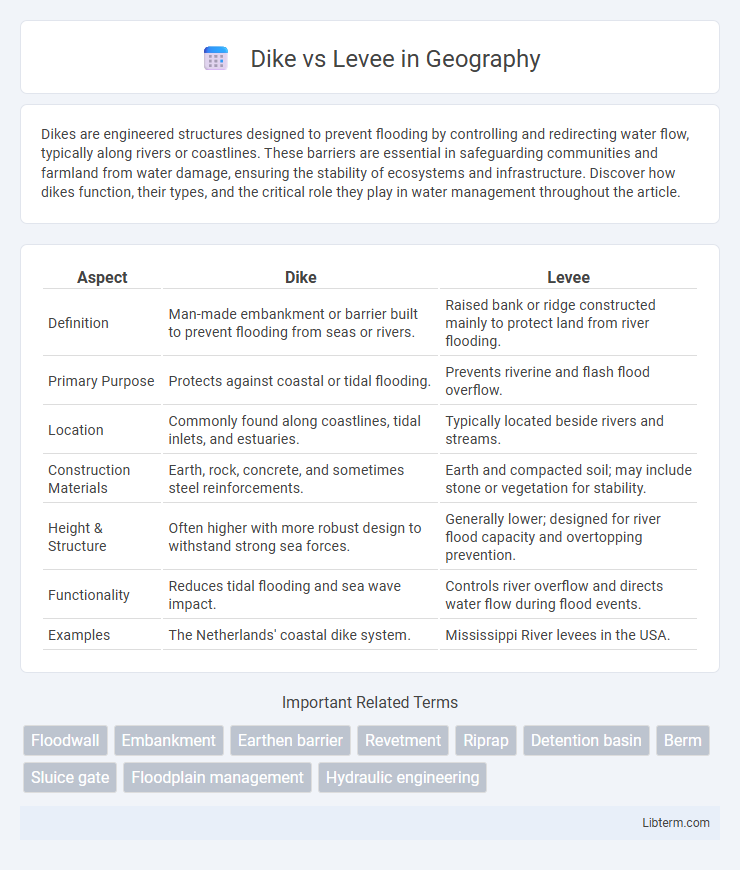Dikes are engineered structures designed to prevent flooding by controlling and redirecting water flow, typically along rivers or coastlines. These barriers are essential in safeguarding communities and farmland from water damage, ensuring the stability of ecosystems and infrastructure. Discover how dikes function, their types, and the critical role they play in water management throughout the article.
Table of Comparison
| Aspect | Dike | Levee |
|---|---|---|
| Definition | Man-made embankment or barrier built to prevent flooding from seas or rivers. | Raised bank or ridge constructed mainly to protect land from river flooding. |
| Primary Purpose | Protects against coastal or tidal flooding. | Prevents riverine and flash flood overflow. |
| Location | Commonly found along coastlines, tidal inlets, and estuaries. | Typically located beside rivers and streams. |
| Construction Materials | Earth, rock, concrete, and sometimes steel reinforcements. | Earth and compacted soil; may include stone or vegetation for stability. |
| Height & Structure | Often higher with more robust design to withstand strong sea forces. | Generally lower; designed for river flood capacity and overtopping prevention. |
| Functionality | Reduces tidal flooding and sea wave impact. | Controls river overflow and directs water flow during flood events. |
| Examples | The Netherlands' coastal dike system. | Mississippi River levees in the USA. |
Introduction to Dikes and Levees
Dikes and levees are engineered embankments designed to prevent flooding in low-lying areas by controlling water flow from rivers, seas, or lakes. Dikes typically refer to large, sturdy barriers usually found along coastlines and tidal zones, while levees are often smaller structures built alongside rivers or streams. Both play crucial roles in flood management and land reclamation, with materials ranging from earth and rock to concrete.
Definition of Dike
A dike is a structure built to prevent flooding from a body of water, typically constructed by raising earth or stone embankments along rivers, seas, or lakes. Unlike levees, which are often natural or artificial ridges that confine river flow, dikes are engineered barriers specifically designed to manage water levels and protect low-lying areas. These hydraulic constructions are essential in countries like the Netherlands, where they safeguard land from sea encroachment and storm surges.
Definition of Levee
A levee is an engineered embankment designed to prevent the overflow of rivers and protect adjacent land from flooding, typically constructed from earth, stone, or concrete. Unlike dikes, which may also serve to reclaim land from the sea, levees specifically function to contain river water within designated channels during high flow conditions. Effective levee systems are critical in floodplain management, reducing the risk of catastrophic flood damage in vulnerable communities.
Primary Functions and Purposes
Dikes primarily serve as barriers to prevent flooding from bodies of water such as rivers, seas, or lakes by holding back high water levels and storm surges. Levees function to contain or redirect river flow within its banks, reducing the risk of overflow during heavy rains or snowmelt. Both structures are engineered to protect human settlements and agricultural lands from water inundation, but dikes often provide broader coastal or floodplain defense while levees are typically constructed along riverbanks.
Structural Differences
Dikes are typically built with earthen materials and reinforced with grass or other vegetation to stabilize slopes, designed to hold back water from rivers or seas. Levees often consist of compacted soil, sometimes combined with concrete or riprap, focusing on preventing flooding by elevating land adjacent to water bodies. Both structures serve as flood defenses, but dikes emphasize slope reinforcement while levees prioritize height and continuous embankment strength.
Materials and Construction Methods
Dikes are typically constructed using earthen materials such as clay, sand, and rocks, often layered to enhance water resistance and stability, employing techniques like compaction and slope reinforcement. Levees primarily consist of compacted soil or rubble with an emphasis on creating an elevated barrier through embankment construction, sometimes incorporating modern materials like geotextiles to improve durability and seepage control. Both structures rely on strategic layering and vegetation to prevent erosion, but dikes are usually engineered for larger-scale flood protection, requiring more extensive foundational work.
Geographic Usage and Applications
Dikes are predominantly used in European countries such as the Netherlands and Germany, where low-lying lands require extensive flood protection through earthen embankments constructed along coastlines and riverbanks. Levees are common in North America, especially in the Mississippi River Basin, serving as raised embankments designed to control river overflow and protect agricultural and urban areas. Both structures serve vital flood management roles but are adapted to different geographic and hydrological conditions.
Advantages of Dikes
Dikes offer superior protection against flooding by being engineered with strong, natural materials like clay and earth, which provide flexibility and resilience under water pressure. Their design allows for easier maintenance and adaptation to changing environmental conditions compared to levees, which are often constructed from rigid materials. Furthermore, dikes support diverse ecosystems by integrating vegetation that stabilizes the structure and enhances biodiversity along riverbanks and coastal areas.
Advantages of Levees
Levees provide effective flood protection by forming continuous embankments that prevent water from overflowing into inhabited areas, thus safeguarding communities and infrastructure. Their construction using earth, concrete, or other materials offers flexibility in design and scalability for extensive riverbanks or coastal regions. Maintenance and reinforcement of levees are relatively straightforward, enhancing their long-term resilience against fluctuating water levels and extreme weather events.
Dike vs Levee: Key Differences and Conclusion
Dikes are embankments specifically designed to prevent flooding from seas and rivers, typically constructed using earth, rock, or concrete to hold back water during high tides or storm surges. Levees, on the other hand, are raised banks along rivers or streams primarily engineered to control river flooding by containing overflow within the channel. Understanding the distinct structural purposes and geographical applications of dikes and levees is crucial for effective flood risk management and infrastructure planning.
Dike Infographic

 libterm.com
libterm.com